
Dolichoderinae is a subfamily of ants, which includes species such as the Argentine ant, the erratic ant, the odorous house ant, and the cone ant. The subfamily presents a great diversity of species throughout the world, distributed in different biogeographic realms, from the Palearctic, Nearctic, Afrotropical region and Malaysia, to the Middle East, Australian, and Neotropical regions.

Linepithema is a genus of small ants in the subfamily Dolichoderinae.
Gracilidris humiloides is an extinct species of ant in the genus Gracilidris. It was discovered in the Dominican amber, only known from a single specimen, described by Wilson in 1985.

Linepithema anathema is a species of ant in the genus Linepithema. Described by Wild in 2007, the species is endemic to Brazil.

Linepithema anathema is a species of ant in the genus Linepithema. Described by Emery in 1894, the species is endemic to South America.

Linepithema aztecoides is a species of ant in the genus Linepithema. Described by Wild in 2007, the species is endemic to Brazil and Paraguay.
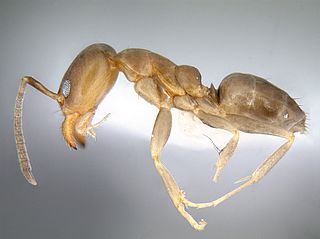
Linepithema cerradense is a species of ant in the genus Linepithema. Described by Wild in 2007, the species is endemic to South America.

Linepithema cryptobioticum is a species of ant in the genus Linepithema. Described by Wild in 2007, the species is endemic to South America.
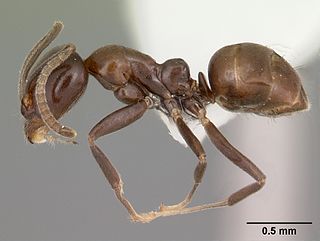
Linepithema dispertitum is a species of ant in the genus Linepithema. Described by Forel in 1885, the species is endemic to South America.
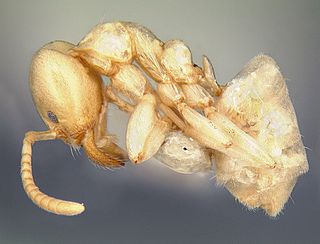
Linepithema flavescens is a species of ant in the genus Linepithema. Described by William Morton Wheeler and Mann in 1914, the species is endemic to Haiti.

Linepithema fuscum is a species of ant in the genus Linepithema. Described by Mayr in 1866, the species is endemic to South America. Linepithema fucsum was the first species-level name assigned to genus Linepithema by Mayr. It is related to L. angulatum, L. keiteli, L. piliferum and L. tsachila. However, only Linepithema fuscum remains without a worker association and it could be possible that males of Linepithema fuscum actually belong to the workers of L. angulatum. Little is known about Linepithema fuscum due to the scarcity of the collected samples.
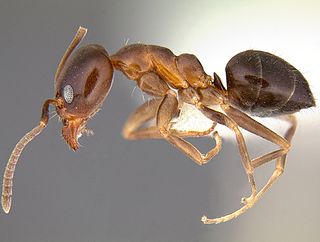
Linepithema gallardoi is a species of ant in the genus Linepithema. Described by Juan Brèthes in 1914, the species is endemic to South America.
Linepithema inacatum is a species of ant in the genus Linepithema. Described by Bolton in 1995, the species is endemic to Argentina and Brazil.

Linepithema keiteli is a species of ant in the genus Linepithema. Described by Forel in 1907, the species is endemic to Haiti.

Linepithema leucomelas is a species of ant in the genus Linepithema. Described by Emery in 1894, the species is endemic to Brazil.

Linepithema micans is a small species of ant from the genus Linepithema which was described by Forel in 1908. This ant is endemic to southern South America. In Brazil, it is considered a pest of vineyards in acting as the main species associated with the coccid Eurhizococcus brasiliensis. It is still a poorly studied species. Their abundant larvae are round and whitish, almost indistinguishable from the proximate species Linepithema humile, better known as the invasive Argentine ant.

Linepithema oblongum is a species of ant in the genus Linepithema. Described by Santschi in 1929, the species is endemic to South America.

Linepithema piliferum is a species of ant in the genus Linepithema. Described by Mayr in 1870, the species is endemic to South America.

Linepithema tsachila is a species of ant in the genus Linepithema. Described by Wild in 2007, the species is endemic to Ecuador.
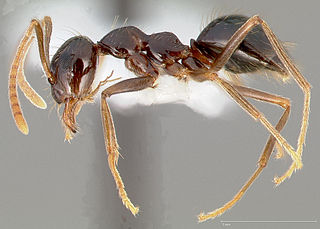
Prenolepis imparis, commonly known as the winter ant, false honey ant, or false honeypot ant, is a species of ant in the genus Prenolepis. The species is found in North America, from Canada to Mexico, nesting deep within the ground. Unusual among ants, Prenolepis imparis prefers lower temperatures, including near freezing, and is only active outside the nest during winter and early spring. Prenolepis imparis enters a hibernation-like state called aestivation during the summer.


















